Naming my favorite book from last year is a no-brainer: Born to Run: A Hidden Tribe, Superathletes, and The Greatest Race the World Has Never Seen. As Jon Stewart blurted with giddiness during his Daily Show interview with author Christopher McDougall, “It’s a great book—a really gripping read!”
I’m therefore happy to spread the word about a chance to hear from the author and other trail-running characters in his book. They’re touring the country April through June to promote the paperback release and spread the gospel of barefoot running in what they’re calling The Naked Tour—”naked” as in stripping down to running’s bare essentials, not bare buns. The Bay Area event is Saturday, April 9, at The Book Passage in Corte Madera.
I recently had the chance to ask Chris McDougall some questions about his running, his upcoming plans, and his belief that the running shoe industry hawks a lot of “junk” that causes injuries.
Anyone who reads this blog, or who pays any attention to the bestseller list, likely is familiar with the fascinating story behind the book—the drama of a race that takes shape in a remote canyon in Mexico between a top American ultrarunner and the Tarahumara tribe, who run free of the ailments and injuries that plague modern runners. McDougall’s tangents get into human evolution, ultrarunning championships and the running industry while capturing the pure thrill of running. For more background, check out this synopsis. I hope you’ll buy the book if you haven’t read it.
Q&A with Christopher McDougall
Me: How’s your running these days?
CM: I’ve been having a great winter. I’ve been going out with some local trail runners who are insanely indifferent to ice storms, snowdrifts, and nightfall. Once we were at the trailhead before a run and I made the mistake of commenting that the freezing rain and total darkness we were about to set off into was awful. “Awfully cool!” someone immediately piped up. And she was right; five minutes later, we were slipping and scrambling around and having a blast.
Your running-related foot pain sparked your research for Born to Run. How are your feet? Did they ever start hurting again after you changed your form and footwear?
My feet have been fine, although my groin surprised me by cramping like a fiend during a recent 50K. That’s the only race I’ve had in my sights lately. It was half-great; I was ahead of pace and feeling excellent through Mile 17, and then I got this wicked groin cramp that wouldn’t let up for the last 14. Very humbling and a little alarming to your fellow racers when you’re stumbling through the woods with a hand in your crotch.
How did writing Born to Run change your life as an athlete? How did it change your life overall?
Not to over-dramatize it, but it gave me back the use of my legs. For years, I’d been told by doctors that running is bad for the human body, especially human bodies the size of mine. And naturally, I believed them because I was always hurt. It came as a shock to discover that stripping away the technology and learning how to run properly could solve those problems. I haven’t missed a day of running because of injury since then. Now, if I can just figure out what happened to my groin during that race on Sunday, I’d be all set!
These days, I can’t look at a running magazine without being bombarded with ads for new minimalist shoes and advice about barefoot running.
True, but when haven’t you opened a running mag and been bombarded by shoe ads?
So how does it feel to have been a huge catalyst for the trend?
I’m grateful I could be associated with the move back toward a focus on running form, as opposed to running footwear, but it was a change that was bound to happen. It was becoming too apparent that all that techno-jargon you hear about shoes had nothing to do with preventing injuries and everything to do with marketing over-priced, unhelpful products.
You once said in an interview that you puzzle over how the running industry can sort of “skate by the growing body of evidence that a lot of the stuff we’re told to buy is complete junk. Not just neutral junk, either, but really dangerous stuff.” What kind of stuff are you talking about?
Footwear. All those moldable inserts and overly-engineered shoes which are supposed to improve your running and instead make it worse. Last June, the British Journal of Sports Medicine published a paper, co-authored by a top Nike researcher, which found that every runner in the study who should have benefited from a motion-control shoe ended up hurt. As the study put it, “It is noteworthy that every runner who trained in the motion-control shoe with a highly pronated foot posture reported an injury.” Amazing—a 100 percent casualty rate among runners in motion-control shoes. And the researchers’ conclusion? “Our current approach of prescribing in-shoe pronation control systems on the basis of foot type is overly simplistic and potentially injurious.” Even Benno Nigg, the biomechanist who first proposed the idea of motion-control shoes and helped design them, has admitted they do more harm than good. And yet shoe companies keep making them, magazines keep promoting them, and running stores keep pushing them. It’s bizarre. Any other product described as “potentially injurious” would be pulled off the shelves. Yet even though the same people who designed motion-control shoes are now saying they’re useless and probably dangerous, the magazines and specialty stores that runners rely on for advice are still pushing them.
What do you hope to accomplish with the Naked Tour, beyond promoting sales of your paperback release?
I wanted to let some of the key thinkers in Born to Run, like Scott Jurek and Dr. Daniel Lieberman and Eric Orton, step off the pages to speak for themselves. I’ve spoken a lot on their behalf lately, so I thought it would be fun to have them join me on stage and let them tell their own stories. And rather than just talk, why not get out there and actually move? So all of the events will have a “naked” run, giving us a chance to get outside and enjoy a taste of back-to-basics running.
Who will lead the run group at the April 9 Bay Area event?
I’ll be joined by Eric Orton, Sunny Blende, and hopefully Scott Jurek and Luis Escobar if they can make the timing work.
You profiled a lot of big names in the book. Did any of them have unfavorable reactions to your portrayal of them? I’m wondering in particular about Jenn Shelton and Ann Trason.
The only person who contacted me with a complaint was Dean [Karnazes]. I hope and would expect that Jenn and Ann are OK with their depictions in the book, because to me they’re two of the most heroic, inspiring, and exciting athletes imaginable.
What did Dean complain about?
I’m not sure I completely understand Dean’s objection. I think he wasn’t happy that I quoted Scott Jurek saying that Dean’s running stunts are running stunts.
Where in the world do you yearn to travel and run?
Maybe it’s because I’ve been traveling a lot over the past few years, but I’ve become a total homeboy. I love hitting the trails out here in Amish farm country in Pennsylvania. … But I’d also love to get back to Portugal, where I lived for four years as a foreign correspondent. The wilderness and wild coastlines are spectacular and easily accessible, and the food is killer. And years ago, I mapped out a dream run that I’d still like to do: traveling by foot among Spain’s White Villages in the southeastern mountains near Jerez.
What’s your next big project—a follow-up book? BTR movie?
Peter Sarsgaard has been working on a movie, but it’s still in the very early stages. Likewise for the new book I’m working on.
What subjects or questions do you want to dig into now?
I’ve got a pretty enticing idea that I’m researching now, but I want to get more done before I start yapping about it.
Thanks, Chris!
My position on the barefoot or minimalist running debate
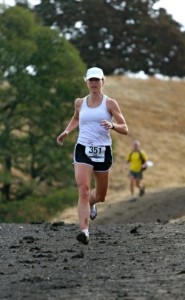
My first experience running barefoot: When the mud on Mt. Diablo became unbearably gummy, I ditched my shoes and won the race.
When people ask my position on barefoot running and the pros and cons of supportive, motion-control shoes with higher soles, I stand in the middle but lean toward minimalist. I’m not a true convert—not yet, anyway—even though the research in Born to Run is compelling. I once won a 10K running barefoot and used Vibram FiveFingers to rehab my broken foot. But I also have a foot injury that’s aggravated by pronation, and I’m convinced that more stable shoes with arch supports recently helped me get the pain under control.
For runs on pavement or rocky terrain, I still lace up my Asics GT 2160s that have the kind of moldable inserts that McDougall derides. But at the track, I sometimes kick off my shoes to do laps barefoot on the soft surface of the turf. Those barefoot laps improve my form and exercise the myriad muscles in my feet that are overly protected in my Asics. They also make my feet feel good!
When I run the American River 50M in a couple of weeks, I definitely want to be in my cushioned, supportive Asics. But I’m starting to believe that “less is more” when it comes to running shoes, and I recently bought a pair of New Balance Minimus trail shoes. I’m cautiously and gradually transitioning to them, and I’ll report back on how they work.

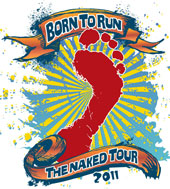
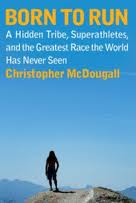
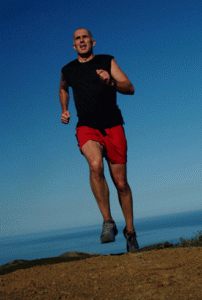
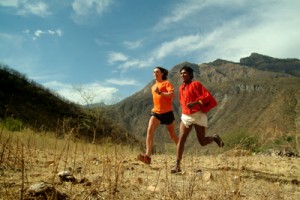
Nice interview and i feel very similar to your thoughts on minimal shoes. It’s hard not to see the minimal shoe marketing as no more than that though with so many jumping on the band wagon. Barefoot Teds blog has more banners and adverts than i’m happy with too.
I sit in the middle with regards to this movement and see good form is key. If this is achieved via minimal shoes then great- but being sensible about form can come from just that in my eyes. No doubt mixing it up is key and can’t hurt! Right?
After a winter of rest and other sports i’d like to introduce more minimal running into my plans too. Meanwhile i think of just trail runs rather than training runs. How bliss!
Sarah,
What an interesting post! I enjoyed the interview; and in the chance that Christopher will be checking back for comments, I want to let him know that “Born to Run” was on my holiday AP Language and Composition holiday reading list (kids were required to read a non-fiction work of their choice, and then report back on it). One of my students, a cross-country standout who will likely be competing in States this year, was really inspired by the book and wrote a great review of it.
Fun to see a connection between the ‘life’ of your blog and my own!
–David
I’ve read the book twice and given it to my three daughters, grand daughter and grandson. Even if not all of them are into running (although we do an annual Carlsbad 5000 as a family…kids too) the book has incredible human stories and demonstrates how a person can be a little(or more than a little) nuts but a great person at the same time…with great spirit and essential goodness and beauty. Maybe my favorite book ever.
Actually make me cry at the wonderful accomplishments, spirit and crazyness of great people…that we are even members of the same species. Heroic. Inspiring.
hm-m-m…ran barefoot in soft and then wet stabile sand for the first time in many years. Really enjoyed it while running but my left gluteus maximus was sore as hell the next day.
Would like to see a video or demo of the specifics of the changes in running style, foot strike and stride with shoes then without. The desription written about by Chris was great and I think I understood the changes but a visual would be helpful. youtube?